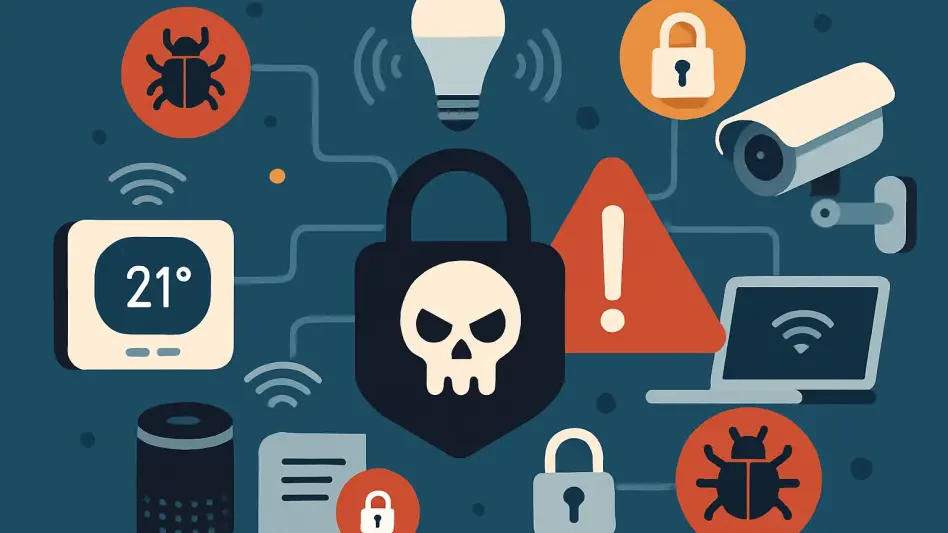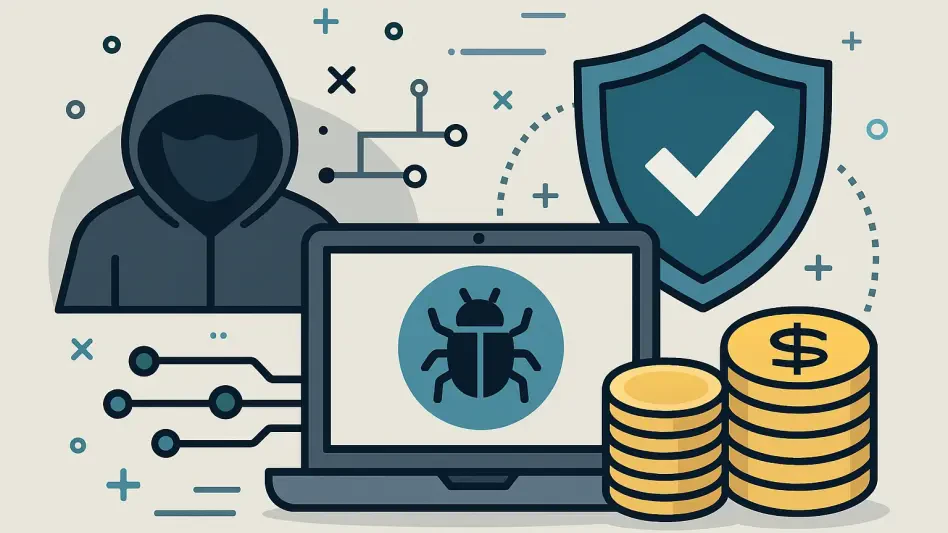The Internet of Things (IoT) has woven itself into the fabric of modern life, connecting everything from household appliances to critical infrastructure systems, but with over 65% of networked devices now classified as non-traditional IT assets, the security risks tied to this sprawling ecosystem are staggering. This pervasive connectivity, while driving efficiency across industries, exposes a vast attack surface that cybercriminals are eager to exploit. How can organizations safeguard their networks when the very devices enabling progress—such as IP cameras and medical equipment—become potential gateways for devastating attacks? This review dives deep into the security challenges of IoT and the broader extended Internet of Things (xIoT) landscape, evaluating vulnerabilities, real-world impacts, and emerging solutions to secure an increasingly connected world.
Understanding the IoT and xIoT Ecosystem
The IoT represents a network of interconnected devices communicating seamlessly to enhance functionality across sectors. Beyond traditional IT systems like laptops and servers, the xIoT framework encompasses a wider array of assets, including operational technology (OT) used in industrial settings and the Internet of Medical Things (IoMT) critical to healthcare. This expansion reflects a seismic shift in network composition, where devices once considered peripheral now play central roles in daily operations, from smart thermostats to industrial sensors.
This shift is not merely technological but also cultural, as businesses and public sectors increasingly rely on connected systems for efficiency and innovation. Non-IT devices, which include everything from surveillance equipment to specialized medical tools, dominate modern networks, often outnumbering conventional IT assets. Their integration into critical infrastructure amplifies both their utility and the stakes of securing them against malicious interference.
The relevance of this ecosystem cannot be overstated, as it underpins essential services and economic stability. Industries such as energy, transportation, and healthcare depend on xIoT for real-time data and automation, making security a paramount concern. As connectivity grows, so does the urgency to address the unique challenges posed by this diverse and dynamic environment.
Key Components and Vulnerabilities of IoT Systems
Dominance of Non-Traditional IT Assets
A striking reality in today’s networks is the overwhelming presence of non-IT devices, which account for a significant portion of connected assets. Items like IP cameras, VoIP phones, and network equipment now constitute a majority, creating blind spots for security teams accustomed to managing traditional IT systems. This dominance shifts the focus of cybersecurity efforts toward an unfamiliar landscape where standard protocols often fall short.
These devices, while essential for operations, lack the robust security features inherent in conventional IT infrastructure. Many are deployed with default configurations or outdated firmware, making them easy targets for exploitation. The sheer volume of such assets in networks—often unmanaged or unmonitored—expands the attack surface, leaving organizations vulnerable to breaches that can cascade across systems.
The challenge lies in adapting security strategies to account for this evolving composition. Without visibility into these non-traditional assets, organizations struggle to detect threats or enforce protective measures. This gap underscores a critical need for tools and policies tailored to the unique risks of a device-heavy network environment.
Device Diversity and Complexity
Another layer of difficulty arises from the heterogeneity of IoT devices within the xIoT ecosystem. Organizations manage a vast array of device functions, vendors, and operating system versions, each with distinct security requirements and vulnerabilities. This diversity, while enabling specialized applications, complicates efforts to maintain a cohesive defense strategy.
For instance, industries like oil and gas or healthcare often rely on equipment from thousands of unique vendors, each contributing to a fragmented security posture. The presence of multiple operating systems further exacerbates the issue, as patches and updates are not uniformly applied across platforms. Such complexity hinders the ability to standardize protections or respond swiftly to emerging threats.
This intricate web of devices creates a persistent challenge for IT teams tasked with securing networks. Without a unified approach to manage this diversity, vulnerabilities remain unaddressed, providing attackers with multiple entry points. Addressing this issue demands innovative solutions that can adapt to the varied nature of connected technologies.
Emerging Threats in the IoT Landscape
The threat landscape surrounding IoT has evolved rapidly, with attackers increasingly targeting connected devices as conduits for broader network infiltration. Sophisticated ransomware and malware now exploit unmanaged assets, using them as stepping stones to compromise sensitive systems. These tactics reveal a growing cunning among threat actors who capitalize on the often-overlooked weaknesses in IoT infrastructure.
Hybrid and cloud environments, integral to modern IoT deployments, add another dimension of risk. Traditional security measures, designed for static on-premises setups, struggle to keep pace with the dynamic nature of cloud-connected devices. This mismatch allows threats to proliferate undetected, as attackers leverage misconfigurations or unpatched flaws to gain footholds.
Moreover, the rise of botnets and targeted malware campaigns underscores the urgency of addressing these vulnerabilities. Devices exposed to the internet with default credentials or outdated software become prime targets for exploitation, enabling attackers to orchestrate large-scale disruptions. As threats grow in sophistication, the need for proactive and adaptive defenses becomes ever more apparent.
Real-World Impacts Across Industries
The consequences of IoT security failures are not theoretical but vividly evident across multiple sectors. In financial services, where over half of networked devices fall outside traditional IT, vulnerabilities in ATMs and surveillance systems pose significant risks. Breaches in these environments can lead to substantial financial losses and erode public trust.
Healthcare, with its heavy reliance on connected medical devices, faces equally dire implications. The exploitation of IoMT equipment can disrupt patient care, as seen in ransomware attacks targeting hospital networks through unsecured devices. Such incidents highlight how security gaps in xIoT can directly impact human lives and operational continuity.
Other industries, like oil and gas, encounter unique challenges due to their use of operational technology in remote and harsh conditions. A single breach in an industrial control system can halt production or cause environmental damage, amplifying the stakes of securing these assets. These real-world examples demonstrate the tangible and far-reaching effects of IoT vulnerabilities on critical infrastructure.
Challenges in Securing IoT Networks
Securing IoT environments presents a host of obstacles, starting with weak configurations that plague many connected devices. Default passwords and misconfigured settings are common, providing easy access for attackers. Without proper oversight, these basic lapses create vulnerabilities that can be exploited with minimal effort.
The lack of network segmentation further compounds the problem, allowing threats to spread laterally once a device is compromised. Many organizations fail to isolate critical systems from less secure IoT assets, enabling attackers to move freely within networks. This systemic issue reflects a broader gap in designing architectures that prioritize containment over connectivity.
Additionally, unpatched vulnerabilities and end-of-life devices remain persistent hurdles. Slow patching cycles and the inability to update outdated hardware leave networks exposed to known exploits. Developing robust visibility tools and security controls to address these ingrained challenges is essential, yet progress remains uneven across industries and organizations.
Future Directions for IoT Security
Looking ahead, the trajectory of IoT security hinges on advancements in continuous monitoring and risk-based remediation. Emerging solutions aim to provide real-time insights into network activity, enabling organizations to detect and respond to threats before they escalate. Such proactive measures are critical in a landscape where static assessments are no longer sufficient.
Cloud-native platforms represent a promising avenue for enhancing security, offering scalability and adaptability to manage diverse device ecosystems. These tools can prioritize risks based on context, ensuring that limited resources are allocated to the most pressing threats. As adoption grows, they could redefine how organizations approach the protection of connected environments.
The long-term impact of securing IoT extends beyond individual organizations to society at large. Aligning security practices with technological growth will be vital to sustaining innovation without compromising safety. Over the coming years, from 2025 to 2027, expect a surge in collaborative efforts to establish standards and frameworks that bolster resilience across the xIoT spectrum.
Final Thoughts
Reflecting on this exploration of IoT security risks, it is clear that the dominance of non-traditional IT assets and the complexity of device diversity pose unprecedented challenges to network protection. The real-world impacts across industries like healthcare and financial services underscore the urgency of addressing vulnerabilities in connected systems. Emerging threats, coupled with systemic issues like weak configurations, paint a sobering picture of the current state of cybersecurity.
Moving forward, organizations must prioritize the adoption of continuous monitoring tools to gain visibility into their sprawling networks. Investing in cloud-native solutions that offer contextual risk assessment proves to be a practical step toward mitigating threats. Additionally, fostering industry-wide collaboration to develop standardized security protocols could pave the way for a more secure future, ensuring that the benefits of IoT are not overshadowed by preventable risks.








